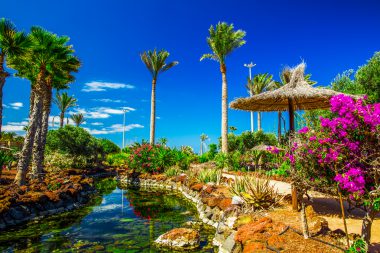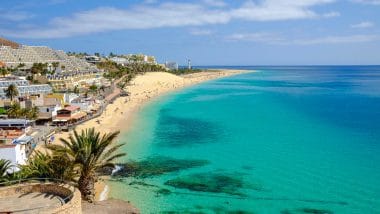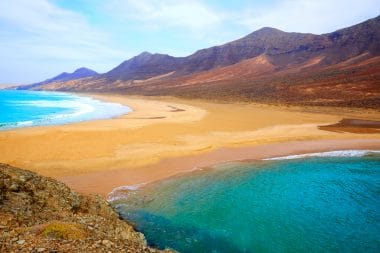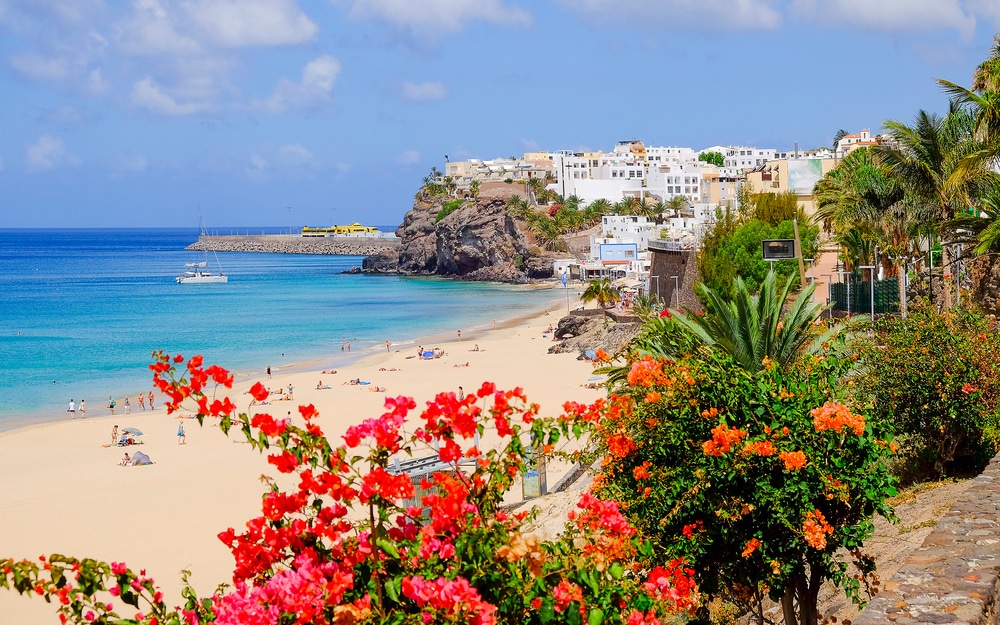Why Fuerteventura? It’s not love at first sight. Once upon a time, Spanish rulers banished unpleasant contemporaries to the second largest island of the Canary Islands in Spain. Admittedly, at first glance the island seems a bit barren, not very varied, many sights do not seem spectacular and then this wind…
It’s worth taking a second look. Look and look again very closely. Fuerteventura is an island that you have to get involved with. Here you stick your nose in the wind and your feet in the sand, without much fanfare, quietly, secretly and quietly.
The island does not show off, it is not loud, it does not challenge and many things unfold their effect quite incidentally. High mountains and deep valleys, white sandy beaches and black lava – Fuerteventura is a lovable island full of contrasts.
Fuerteventura – where heaven and earth merge

“Here heaven and earth merge, here they become one in the embrace of the sea” – once said Miguel de Unamuno, one of the most famous contemporaries exiled to the island. He described the island as an “oasis in the desert of civilization”.
One thing has changed, of course: civilization has taken hold. Bungalows, holiday home settlements and terraced hotels nestled on the slopes form artificial oases. Sun, sand, and sea have made the island famous.
Let’s start on the east coast, where Puerto del Rosario, the capital of the island, spreads out. Although the city does not shine with age or special beauty, if you want to get to know a piece of the Canarian way of life, the island’s capital is the right place for you.
After all, the port city declares itself the liveliest town on the island. And there is also a bit to stroll and look at.
Particularly worth seeing in Puerto del Rosario:
- The Museo Unamuno, dedicated to the most famous “guest” of the island. During his exile, the philosopher lived in the small house, which gives an impression of the living culture of the 1920s.
- There are many interesting works of art to discover in Parque Escultórico. More than 100 sculptures and sculptures decorate streets and public squares. It is a joint work of Canarian and international sculptors.
Continue to Corallejo. The town is more colourful and entertaining than any other place. It is a charming “village” with a charming old town, diverse and international – you will look in vain for bed castles here.

That’s more or less how you imagine a perfect holiday: surfing in front of seemingly endless dunes, which provide a spectacular backdrop for the annual colourful kite festival. The 20 square kilometre El Jable dune area merges seamlessly into the beach on the southern edge.
The fine sandy, kilometre-long Grandes Playas super beach starts just outside at the two Riu hotels. On the rarely crowded sandy beaches, bathing enthusiasts, sun-seekers and nudists cavort. Meanwhile, small bathing bays invite you to linger in the town centre. The second largest holiday centre in Fuerteventura shines with excellent surf spots and a lively club scene. In the evening, there is a hearty holiday hustle and bustle in the pedestrian zone and on the main street.
From the ferry port, excursions to Lanzarote and Lobos are possible. Only 20 minutes by boat separate Corralejo from the island of Lobos. Into the wilderness for a few hours! Visitors should not miss a trip to the offshore “Seal Island”.
However, it is not worth keeping an eye out for seals. There is none. But the island captivates with a charming beach, a ring-shaped hiking trail and a tiny village. Lobos is car-free and is a nature reserve. Despite the dominating black lava boulders, the island looks green and colorful.
Beyond the beach – Fuerteventura, a hiking hit

Swimming, diving, surfing, surfing and beach running are no longer the only things you can do in Fuerteventura. Active people and hikers have discovered the island for themselves and conquer wonderful paths that lead through wave-like eroded hill chains.
Hiking tours on Fuerteventura grant a soothing peace and quiet, magnificent views and accompany you a bit into solitude. Few plants decorate the roadside, vultures circle in the sky and you meet animals that only crawl and wheeze in this region. Shady forest paths should not be expected.
Instead, palm oases scattered in the mountains, which correspond with their strong green, adorned with brown peaks and the azure blue sky, underline the austere beauty of the island. The mountain village of Vega de Río Palmas lives up to its name. The old capital Betancuria, which is idyllically located in the high valley, can also boast numerous stately date palms. Meanwhile, iridescent earth colours from brown to ochre give the island a brittle charm, and make many a hike an experience.
Tip: Hikes across the island of Lobos, to the wild west coast and up the 807-meter-high Pico de la Zarza are particularly popular.
Between beautiful country towns and impetuous surf
El Cotillo
The former fisherman’s nest is a sleepy village. If you’re looking for chic boutiques and a promenade for strolling, this is the place for you. Instead, you can climb the Torre del Tostó defensive tower from 1740. From here there is a wonderful view of the west coast. When the waves crash against the rocks, an impressive spectacle follows.
Betancuria
The mountain village of Betancuria can only be reached via a winding mountain road. A visit to the historic place is worthwhile. The country town was founded in 1405 by the Norman conqueror Jean de Béthencourt. Until 1835, it was the official capital of the island.
Ajui

Ajui is a small fishing village on the west coast, which is hardly developed for tourism. Only since 1986 has there been electricity and running water here. It is a popular excursion destination, from which beautiful hikes can be made along rocky capes and small bays on the indented coast.
A footpath leads from the north end of the beach over a white rocky plateau to the bay of Caleta Negra. There are huge caves washed out by the sea. Another destination is the impressive Peña Horadada rock gate. In front of it is a natural swimming pool where you can cool off.
Nothing but sun, sand and sea – welcome to the south: picture-perfect Fuerteventura!
Playa Barca / Costa Calma
On the Jandía peninsula, the sprawling holiday town lives up to its name (Silent Coast). The beautiful beach is not only popular with families. Playa Costa Calma is one of the best that the beach paradise of Fuerteventura has to offer – fine golden yellow powder sand over a length of 10 kilometers. Further south, at Playa Barca, windsurfers and kitesurfers will find what is probably the best area in Europe.
Morre Jable / Jandía
The twin town is located at the southernmost point of the island and forms the largest holiday centre in Fuerteventura. Playa del Matorral is one of the most beautiful beaches on the island. Morre Jable is a traditional harbour town in a beautiful location. A lot of bars, restaurants and pretty shops line the representative green main street.
From Morre Jable a rather bad gravel road leads to Playa de Cofete. The drive over dusty, bumpy roads, through a desert-like landscape, still has something adventurous about it. Finally, you reach the top of the pass at Roque del Moro via numerous serpentines. From there you can enjoy the most magnificent view in the entire south of the island.
Result: Take a good look and Fuerteventura has crept into your heart.
Back to travel magazine
Können wir Ihnen helfen?
Benötigen Sie Unterstützung bei Ihrer Reiseplanung oder weitergehende Informationen zu einzelnen Reisezielen? Wir freuen uns über Ihre Kontaktaufnahme.


